“If these landings are successful, we could see crewed flights to Mars within four years.”
SpaceX CEO Elon Musk has a reputation for making bold predictions that don’t always pan out, and his latest statements are no different. Over the weekend, Musk claimed that SpaceX’s massive Starship rocket will begin regular trips to Mars in just two years. It’s an audacious claim, especially given that Starship has yet to complete a full orbital flight or land successfully on Earth even once.
“The first Starship missions to Mars will launch in two years, coinciding with the next Earth-Mars transfer window,” Musk stated, referencing the period when both planets align for the most efficient journey. “These missions will be unmanned, designed to test the reliability of landing the spacecraft intact on Mars. If those landings go well, the first crewed flights to Mars will follow in four years,” Musk added.
Mars … Vault?

Skepticism is warranted when considering Musk’s ambitious timeline. In SpaceX’s most recent test flight in June, Starship and its Super Heavy booster reached outer space, but during its attempt to land softly in the Indian Ocean, one of its landing flaps was compromised by extreme forces, causing the rocket to crash into the water. This marked an improvement over the previous year’s test flights, both of which ended in fiery explosions. However, the journey to Mars represents an exponentially more complex challenge. Currently, SpaceX is still working out how to use its “chopstick”-armed tower to catch Starship during descent, a maneuver that has never been successfully executed. The timing of SpaceX’s next test flight involving this tower remains unclear. In July, Musk predicted an August 3 launch, but it has yet to occur.
Traveling to Mars will require overcoming far more significant hurdles. Despite Starship’s design for full reusability, a single rocket will need to be refueled in Earth’s orbit to make the journey to Mars—a complex procedure in itself. Additionally, landing on Mars without the assistance of Earth’s Mechazilla catching tower will present new challenges. Musk didn’t stop at Mars predictions. “From there, the flight rate will increase exponentially, with the ultimate goal of establishing a self-sustaining city on Mars within 20 years,” Musk said. “Becoming a multiplanetary species will extend the lifespan of consciousness, ensuring we are no longer reliant on a single planet for survival.”
However, whether humanity can escape a rapidly warming Earth remains uncertain. After all, according to Musk, self-driving cars should have been the norm nearly a decade ago. And sending a 165-foot rocket to Mars is an even more daunting task.











